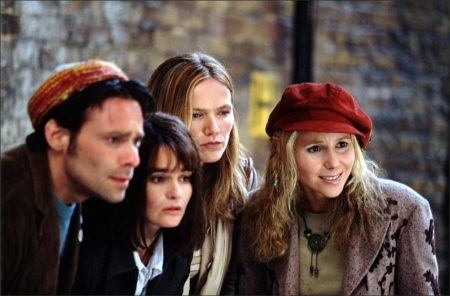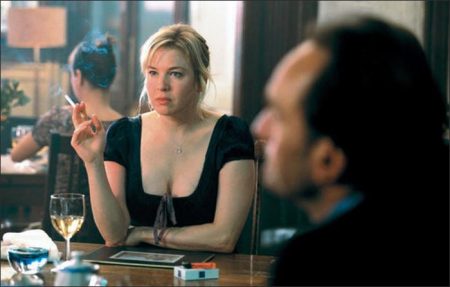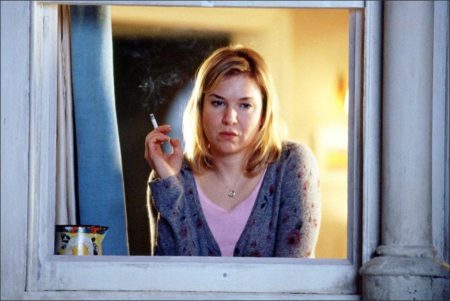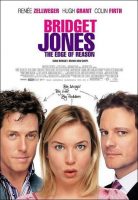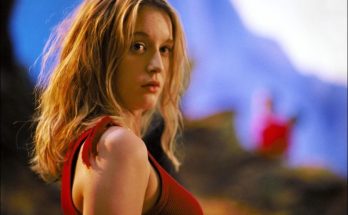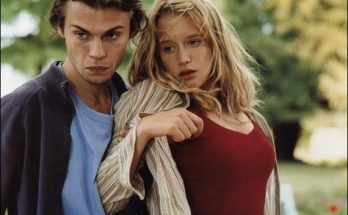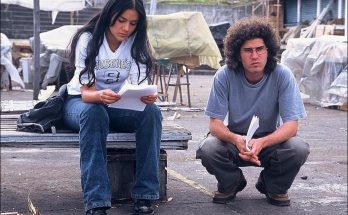Bridget Jones’s Diary: The Edge of Reason Movie Trailer. “We had no idea in the beginning what the reaction to Bridget Jones would be,” notes producer Eric Fellner, “so we were absolutely thrilled that so many people took the character to heart. With Edge of Reason, there was an unusual chance to look at a well-loved character in a new way. Bridget has always been about dreams and fantasies, but now that she’s actually got a boyfriend, she’s faced with trying to live with a more messy reality. I think what Fielding – and Bridget – do so brilliantly in this new story about her is create a picture of woman who faces all the adversity of love and still manages to mostly laugh at it all while coming around to a better understanding.”
Adds producer Jonathan Cavendish: “It was a bit terrifying to make this film, because we knew ahead of time that there would be so much expectation, and that so many people all over the world feel that they have a personal relationship with Bridget. But we were confident that this is a different film – it’s still very funny in that Bridget way, but it addresses issues about love and happiness. There are some familiar elements that audiences will recognize, but also shocks and surprises.”
In searching for a director to take a fresh look at Bridget Jones, the producers were keen to find a passionate and stylish woman who would bring her own perspective to the story. They found what they were seeking in Beeban Kidron, who first drew critical acclaim with her BAFTA-winning film Oranges are Not the Only Fruit and has gone on to direct such films as the critically admired British comedy Antonia and Jane, Used People (starring Shirley MacLaine and Marcello Mastroianni) and the Golden Globe-nominated To Wong Foo, Thanks for Everything! Julie Newmar.
The director was already in thrall with the famous character. “The thing I like so much about Bridget Jones is that there’s a little bit of Bridget in us all,” says Kidron. “She says what many of us are secretly thinking and she fears the same absurd things we all fear and she muddles through life the same way everybody feels that they do, yet she manages to be funny, observant and touching through it all. Her latest obsession in life is one that occupies many of us, men and women alike: what do you have to do to have a successful relationship? Bridget starts out with this fantasy ideal of perfect love with a perfect man, without any conflict. She seems to think that she herself has to be perfect, but the harder she tries, the worse things get.”
For Kidron, watching Bridget take on the new dilemma of being a single woman in love proved to be especially alluring. She explains: “I think for me one of the most interesting things about Edge of Reason is that we get to see Bridget really maturing into someone who realizes that perfection isn’t at all that counts in love… it’s caring, kindness, understanding… all those other grown-up things. Bridget is growing up in this movie, but she’s growing up in her own hilarious way.”
Coming at the project with her own enthusiasm and perspective, Kidron never really looked back to the first episode of Bridget’s story. “I think it really was an advantage that I had nothing to do with the first movie, because this way I didn’t ever have to concern myself with trying to repeat the magic of that experience,” she notes.“I simply was thinking about how to make this particular story into a film in the best way possible and focused on moving forward into a new part of Bridget’s life.”
Bridget is Back: Renée Zellweger Revisits a Bridget Jones on the Edge of Change
“Bridget Jones has cocked things up for the last time.” – Bridget Jones
Once Bridget Jones: The Edge of Reason got underway, one lingering question lay at the very heart of the project: would Academy Award-winning actress Renée Zellweger return to the role she created to so much acclaim-gaining the requisite weight, re-assuming the British accent and embodying Bridget’s hilariously ill-fated yet familiar quest to keep her life on an even keel-in Bridget Jones’s Diary?
For Zellweger, the answer required some careful deliberation. In the end, however, she found that her devotion to Bridget Jones as a character is what ultimately brought her back to the role. “It took me some time to get comfortable with the idea of bringing the character back to life,” admits Zellweger. “I knew it would be a lot of fun to do it again, so that was never the issue. It was simply that I love this character so much that I felt a strong personal responsibility to protect her and preserve the integrity of who she is. She was a such blessing in my life and she’s so special to so many people around the world that I didn’t want to do anything that could compromise her or how people feel about her.
“I’m motivated by telling stories that have not been told before and I felt that there was so much of Bridget’s experience that hadn’t yet been explored,” she continues. “When we began the new phase of Bridget’s journey, I realized that what we were embarking upon was not a simply a sequel, in which similar ground is retread, but that we were moving forward creatively and watching a new chapter in the life of Bridget Jones unfold. That, to me, was a very interesting challenge. It is rare to have the opportunity to revisit a character who has in some way evolved. It was a little scary, too, because I knew that it would be an entirely new process of discovery. This Bridget has definitely grown up in certain respects-she is less naïve, a little more worldly-and yet she is still wonderfully flawed, which is, in large part, why people relate to Bridget and what makes the character beloved.”
Zellweger was particularly attracted to the idea of making a romantic comedy that explores the reality of how truly difficult it is to make relationships work, no matter how blissed-out one might be in the beginning. “I’d never seen a day-to-day account of all the challenges that surface when a person finds that her idealized, perfect relationship is, in reality, not so perfect after all. I thought it could be very amusing to watch Bridget Jones, in particular, explore these experiences in love.”
Bridget Jones: The Edge of Reason finds Bridget throwing herself into a new relationship and new career challenges (not to mention out of a plane), always certain that happiness and success are just around the next corner. This ever-hopeful aspect of Bridget is what Zellweger believes makes the eternally accident-prone character a modern heroine. “One of the things that is so wonderful about Bridget is that no matter how many times she falls on her face, she remains incredibly optimistic,” she observes. “She starts out at the beginning of this story determined to be successful in love and as a journalist and she just can’t imagine what could possibly go wrong… until it all does.”
Jumping into the project on the heels of playing a hard-scrabble rural Southerner in Cold Mountain (and winning an Oscar for Best Supporting Actress in the process), Zellweger also faced the challenge of getting physically and mentally prepared to play the un-thin, style-challenged, self-deprecating Brit who, for all practical purposes, is the svelte American’s polar opposite. Having left her British accent by the wayside, Zellweger had to start essentially from scratch to redevelop it. And then, of course, came the crux of playing Bridget Jones: the weight gain needed to account for Bridget’s constant obsession with her ever-so-slight extra layer of fat. Having bloomed from a size 6 dress to a size 14 once before and lost it, Zellweger was ready to do it again.
“For me, it’s a necessary part of an honest portrayal of who Bridget is,” notes the actress. “If I can’t be her in body as well as in spirit, then what would be the point?” In addition to the “weight work,” Zellweger also prepared to do her own stunts which, as Bridget gets more and more outrageous newsroom assignments, include parachuting into a pig pen in a garish yellow and orange flight suit. “That was a hilarious day,” recalls Zellweger, “a day on which I learned more about pigs than I ever wanted to know!”
In other scenes, Zellweger also had to side step, slide and tumble down an Austrian ski mountain; perform a vamping Madonna imitation in a Bangkok jail; and waddle across the room wearing a skintight gold lame dress that impedes all hip movement. “For me, this role was a great chance to do physical comedy,” she comments. “A vital element of being Bridget is expressing her physically. The way she always manages to fall down, flail around and somehow get back up no matter how embarrassed she might be is part of the essence of who she is. The portrait of her wouldn’t be complete without that.”
The Boys of Bridget: Hugh Grant and Colin Firth Return for a Re-Match
“Ever do it in the dark with a total stranger? OK, maybe not a total stranger…” -Daniel Cleaver
In Bridget Jones: The Edge of Reason, Bridget is not only in love, but trapped between two men who represent starkly different sides of her romantic impulses: on the one side is the entirely too-good-to-be-true human rights lawyer, gentleman extraordinaire and possible marriage candidate Mark Darcy, played by the consummately romantic Colin Firth; and on the other is the far-too-bad-to-resist cynic and inexplicably sexy cad Daniel Cleaver, once again portrayed with comic suavity by Hugh Grant.
Both men relished the idea of returning to their acclaimed roles and getting the chance to explore these characters and their relationships with Bridget more deeply. For Colin Firth, Edge of Reason was a chance to unravel Mark Darcy’s fairytale-like demeanor. This time around, he took the previously unflappable Darcy (modeled after the handsome and haughty love interest of the same name in Jane Austen’s Pride and Prejudice-a character he made his own with his indelible performance in the 1995 miniseries) and let him squirm as he comes to terms, step by dizzying step, with his true feelings for Bridget Jones. For as seemingly tolerant, brilliant and adoring as Darcy is, he also reveals himself to be a recalcitrant neat freak, resistant to change and less than a genius at understanding his heart.
Firth sees this new Bridget Jones chapter as taking a playful wrench to the typical gauzy and starry-eyed movie romance. “There’s a reason why romantic fairytales end where they do, because if they went on, they would start to get messy, if not completely grisly,” he laughs. “But we all know that the reality is quite different. We know that the things that first attract you to a person are the same things that later drive you crazy. We know that two people who come from completely different social backgrounds are not going to be able to help but judge one another. And, because Edge of Reason addresses these things, I think that this film creates a portrait of a relationship that is very comical yet also quite alive and quite real.”
Firth has always been fascinated by Darcy’s affection for Bridget, which reminds him of many real-life relationships he has witnessed between seeming unmatchable opposites who ignite when they come together. “Bridget and Mark are certainly not a likely pairing,” he says, “but I think there are lots of people who are attracted to one another for unfathomable reasons. I think Mark doesn’t exactly know why he’s fallen in love with Bridget, but for one thing, I think he finds her honesty very refreshing. He comes from such a high-powered world of appearances that he is secretly thrilled by her almost complete inability to be fake or to show any sort of guile whatsoever.”
Some of those “disastrous situations” are the direct result of Bridget’s own doubts and petty jealousies-feelings not confined to the female side of the burgeoning relationship. Darcy himself falls occasional prey to the greener end of the romantic emotional spectrum-particularly when it comes to a certain suave former boss from his girlfriend’s past. And in the grand tradition of British chivalry, these conflicting suitors just can’t seem to meet without some kind of (really fairly pathetic) fisticuffs ensuing.
Indeed, picking up a comic refrain from the first Bridget Jones film, Darcy and Cleaver have yet another raging run-in with each other that devolves into perhaps the least skillful, least violent and most drenching extended fight sequence seen in recent cinema. This farcical climactic scene was entirely ab-libbed by Firth and Hugh Grant, without so much as a choreographed move or a minute’s rehearsal.
Says producer Jonathan Cavendish: “I’m here to tell you that Colin and Hugh are the two worst fighters I’ve ever seen – which is why they are absolutely hilarious in this scene.”
“The funny thing is that Hugh and I have only ever worked with each other in these fight sequences,” observes Firth. “But we made the decision right away this time not to stage anything. We simply showed up that morning and started pulling each other’s hair, kicking at one another, flailing about and complaining, and it all came completely naturally to me, I have to say.
“Meanwhile, I believe Hugh asked for the nurse several times, as well as hot water bottles and various medications,” Firth jokes. “But seriously, I think this is a ritual these guys are always going to go through-they’ll be fighting like this when they’re 103. I guess you could say that the Daniel and Mark story will always unfold on a physical playground.”
Adds Hugh Grant: “Middle class Englishmen don’t fight at all really, and when they do it’s a pretty pitiful sight-girly, messy, unbutch-and that’s what we were trying to capture.”
Grant, who went to town creating the simpering, sleazy and yet somehow indescribably seductive Daniel Cleaver for the first Bridget Jones film, returns to create a Cleaver who claims he has radically changed, despite being perhaps even more deliciously depraved than ever. Although Cleaver’s role in Helen Fielding’s novel of Bridget Jones: The Edge of Reason was limited, the screenwriters expanded it for the film to reflect how vital the Hugh Grant character has become in eliciting the susceptible side of Bridget Jones. They brought Cleaver and Bridget back into close contact by making them journalistic partners on a new travel television show ironically entitled The Smooth Guide.
Needless to say, Bridget’s latest liaison with Cleaver turns out to be anything but smooth. Though she begins by calling him “a deceitful, arrogant, sexist, low-minded, disgusting specimen of humanity,” she winds up in a Bangkok hotel room with that same specimen nevertheless, though with an unexpected outcome.
Grant found that upon returning to the role of Cleaver he had all too little trouble sliding back under the character’s skin. “I don’t think I’m quite as black as Cleaver is in his soul, but I certainly share some of the same tastes and frailties,” Grant offers.
For Beeban Kidron, Grant provides the dark comic heart of the film. “Hugh in the role of Cleaver is just mesmerizing,” she states. “He’s a really exciting actor to watch because he actually works very, very hard in contrast to the often laconic characters he plays to whom everything comes so easily. He also has an amazing sense of comedy timing. But, most of all, I think he captures the indescribable essence of that bad boy women desire – the man we don’t want to marry but, in Bridget’s language, we definitely want to shag.
Welcome to Bridget’s World
“Saw him just an hour ago, going into his house with little Rebecca Gillies. Only 22, legs up to there, and Daddy owns half of Scotland…” – Bridget Jones
Bridget Jones’s budding romance is further complicated and nearly blown to bits by a supporting cast of characters who add an array of comic complications to the story of Edge of Reason. A new and key addition to the story is the character of Rebecca, Mark Darcy’s mysterious young colleague, who couldn’t be prettier, richer, leggier or more threatening to Bridget’s idea of romantic bliss. Convinced Rebecca has her eyes, if not more, on Darcy, Bridget has no idea how to defuse the situation, especially because she believes Rebecca is precisely the person Mark wishes Bridget could be in his dreams.
To play Rebecca, the filmmakers chose rising Australian star Jacinda Barrett, who was thrilled to be part of an episode in Bridget Jones’s life. “I read both the books, saw the first movie and was just so excited to be part of this,” she says. “For me, the best part of it all was getting the chance to watch Renée. She brings so much fearlessness to this part. I found myself watching her through Rebecca’s eyes as she stumbles and makes a fool of herself and puts her foot in her mouth, and found her to be both inspiring and incredibly adorable.”
Says Colin Firth of Jacinda Barrett’s performance: “The fun part about Rebecca is that she isn’t quite what she seems. I think it’s one of those roles where the audience will be able to go back a second time and trace the exact moments, the little glances, the subtle signals Jacinda gives that they missed the first time around.”
Even as Bridget battles jealousy and struggles to make sense of her own affairs of the heart, she finds that her incompatible parents are relighting their own romantic torch. Though her mother is as embarrassingly effusive and her father as put-upon and bewildered as ever, even Bridget has to admit they seem to be showing signs of true love after all this time.
Reprising their roles as Mr. and Mrs. Jones, Bridget’s Dad and Mum, are Jim Broadbent and Gemma Jones. Says Broadbent: “What’s lovely about Bridget’s parents in this story is that they realize that things might never be ideal between them, but things would be far worse without one another.”
Adds Jones, “I think Pam has finally come around to realizing he’s actually a good bloke, her husband.”
Adding further comic input to Bridget’s situation are her loyal friends, who provide Bridget with lots and lots of well-intentioned but stunningly bad counsel… which grows even more disastrous when it comes to Mark Darcy. For Sally Phllips, Shirley Henderson and James Callis (who respectively return as Shazzer, Jude and Tom), taking part in another Bridget Jones adventure was a chance for more joyous fun.
“We’re the typical drunk, useless friends who are full of awful advice,” sums up Henderson. “And now that Bridget is going out with someone new, which is the ultimately treachery among urban friends, we of course make it relatively difficult for her to get anywhere. We simply increase her paranoia and neuroses!”
Adds Callis: “I think in a way, these three live vicariously through Bridget, but unfortunately with her being in a new relationship, that means her every move is going to get raked over and analyzed, and not at all professionally.”
Summarizes Sally Philips, whose character Shazzer accompanies Bridget on her tumultuous trip to Bangkok: “The most wonderful part of playing Bridget’s friends is the way in which we all feed so naturally off each other. There’s a very real sort of friends dynamic that has emerged between us all that makes the laughter more real.”
Finally, returning once again in the role of Bridget’s heartless, ratings-chasing boss Richard Finch (who sends Bridget into increasingly perilous and ridiculous assignments for the show Sit Up Britain) is Neil Pearson. “Richard sees Bridget solely from a ratings point of view,” explains Pearson. “He knows people watch her because they’re waiting for disaster to strike, so it’s his job to come up with more and more preposterous things for her to do.”
Pearson also sees his character as having a unique role in the film – as the one person who hasn’t altered himself even a single iota from the first story. “He is the only character who has not progressed, has not grown emotionally and is still the same stunted lech he was before – but luckily everyone else has moved on in life!”
A Globe-Hopping Production (or, Around the World, Bridget Jones-Style)
“All my life I’ve had the feeling that something terrible might happen… and now it has.” – Bridget Jones
In Bridget Jones: The Edge of Reason, the consummate London Girl finds herself far from home, jetting off to Austria for a romantic ski weekend that goes downhill fast and then making her way to Thailand, where she encounters sun, surf, Daniel Cleaver’s attempts at seduction and a run of tourist’s bad luck that lands her in a Third World jail cell. To capture this whirlwind journey around the world which leads to romantic epiphany, director Beeban Kidran worked closely with a director of photography Adrian Biddle and production designer Gemma Jackson to forge a clean, classy, but eminently modern design for the film that suits both Bridget and her new travels.
Kidron saw the film as taking Bridget Jones’s colorful little corner of London and suddenly expanding it outwards, giving Bridget a much bigger, splashier taste of life. “The story begins in London, and there you are immersed in Bridget’s world, where she meets her friends in restaurants, goes to work at Sit Up Britain and has embarrassing little family gatherings-and it’s the familiar place for her,” she explains.
“But very quickly she is taken out of her element, going to Austria on a mini-ski-break, and then even farther afield to Thailand, so we had a chance to show what Bridget is like in the broader world. I saw it as sort of `Bridget Jones as James Bond’-she has the kind of international adventures only Bridget could have. Yet by going so far from home, this allows her to look at her life and feelings for Darcy in a new way.”
For the London sequences, Kidron and crew shot at such classic locations as Tower Bridge, Oxford and Regent streets, Piccadilly, The Temple (London’s legal district) and Chiswick (where a sleek modern office building was transformed into the Sit Up Britain headquarters). Another familiar sight to London visitors are the Italian Fountains in Hyde Park, which form the backdrop for Mark Darcy and Daniel Cleaver’s epic water fight.
The parachuting sequence was shot near Buckinghamshire and resulted in Renée Zellweger being suspended off a 20-foot crane by wires and spending hours in a mud-slashed pig pen – all work she did herself. “Renée impressed me right away with her willingness to not only do her own stunt work but to fall over, put her face into the mud and cavort with animals,” laughs Kidron.
Meanwhile, Bridget’s flat was recreated on an Ealing soundstage, with production designer Gemma Jackson adding just a few new touches to the design she first created for Bridget Jones’s Diary…namely an even vaster collection of self-help books! “We really wanted to keep the look of Bridget’s flat the same, because it’s so reflective of her,” she explains.“It has the look of a place that belongs to someone who’s searching. There’s no particular style – instead it’s filled with different ideas she’s had along the way. Ever since the first film, people have told me, `Oh, you must have seen my bedroom,’ so I think a lot of single women can relate.”
But this time Jackson had a new task: contrasting Bridget’s abode with Mark Darcy’s much statelier, yet stuffier, home.“I think there’s a lot to be seen about the differences between Bridget and Mark from their homes,” says Jackson. “Bridget’s is a warm, comfortable place, a bit messy perhaps, but filled with color and life and things she has picked up on her adventures along the way. Mark, on the other hand, has a rather empty, proper house that isn’t comfy or cozy. It’s serviceable and has some nice heirlooms, but we didn’t put any soul into it because that’s what he finds in Bridget.”
Darcy does manage to work up the courage to ask Bridget on her first ever mini-ski-break – then breaks the mood by also inviting Bridget’s nemesis, Rebecca, who of course flows downs the slopes like a rosy-cheeked pro. This portion of the story was shot in Austria’s Tyrol mountains using the famed, glamorous ski resort and alpine village at Lech. For the skiing sequences themselves, the camera equipment was towed by Snowcats halfway up the high-altitude ski mountain. Meanwhile, Renée Zellweger had to concentrate on making her way down the mountain in disastrous Bridget style.
“Renée volunteered to do the skiing but, at first, we brought in a very experienced skier and stunt woman… only to realize it just wasn’t right,” recalls Beeban Kidron. “Renée has a unique body language for Bridget that is so comedic and so much a part of the role that we had to let her do the stunts. She proved to be very, very brave. She enjoyed herself doing that out-of-control slalom down the mountain. Fantastic. Actually, I was completely shamed by her, because I ended up taking the lift down to the bottom!”
In Thailand, the filmmakers found an environment at the other extreme from drizzly, urban London. “We went from rain and miserable grayness to glorious blue skies and vast beaches,” comments Kidron. “Cinematically, it was great to suddenly have these wide, open landscapes that provided such a contrast to Bridget’s usual habitat. It was a whole new look for the film and whole new perspective for Bridget.”
Locations in Thailand included the idyllic beach resort of Phuket; the 200-year-old Muslim village-on-stilts at Ko Panyee; the ancient Buddhist shrine at Nakornpathom; and a bustling, open-air Bangkok market rife with fruits, fabrics and crafts, not to mention scorpions and snakes.
For several of the Phuket beach scenes, including the one in which Bridget, experiencing the effects of a “magic mushroom” entrée, wades into the ocean on a wave of bliss, the camera crew was situated in traditional Thai boats. “This did get a bit challenging because the boatmen didn’t speak English and they would wind up rowing right when we needed them to go left!” recalls Kidron. “But it all worked out in the end.”
In the stilt village of Ko Panyee, Gemma Jackson and her crew designed a Thai-style restaurant with a stunning view, where Bridget is momentarily swept away during a disturbingly romantic dinner with Daniel Cleaver. Jackson wanted the scene to be right out of a tropical dream.
“In the spot where we wanted to put the restaurant, there was only a concrete foundation-no roof, no walls, nothing except an empty slab of concrete,” explains Jackson. “So we had our work cut out for us. We built a restaurant in the basic Thai architectural style from scratch – we put in the floor, we built the roof, we created the whole thing from the bottom up, which was quite a logistical nightmare because we were so far from any supplies. We had to use whatever we could find locally, but it was worth it because it really looked fantastic in the end.”
Jackson also found herself re-decorating a roadside Thai market. Having found one in Bangkok just outside a spectacular pagoda that Beeban Kidron loved, Jackson made it even more visually exciting. “We simply bought out the stalls that were selling duller items and put in more stalls with beautiful decorations and masses of flowers and handmade things,” she explains. “And then we added stalls with some shocking items like chicken heads and fish parts just to emphasize the exoticness of what you find in Thailand.”
But Jackson’s biggest challenge lay in designing the Thai jail cell in which Bridget finds herself. To keep their set authentic, Jackson and Kidron visited several prisons in Thailand, finding a spotless, rather cheery prison in Phuket and a far more sordid, grim and infamously harsh prison in Bangkok. They made the decision to aim for something in between the two extremes. “Beeban and I wanted it to seem real but not too extreme,” says Jackson. “The idea was that Bridget gets pushed just far enough to find some belief in herself.”
Kidron interjects, “But we were conscious that to deal with the reality of Thai jail life would be completely inappropriate in a romantic comedy.”
In keeping with romantic comedy trumping reality, Bridget finds herself sharing her indomitable spirit with the other women in the jail in an unexpected Madonna-inspired dance number… which further required Jackson to design floating walls to accommodate the unusual shoot. “This part was a lot of fun,” says Jackson. “We wanted the jail to at first have a sense of gloomy reality and loneliness but in the big dance number, it becomes transformed into something very Bridget.”
For Renée Zellweger, the jail scenes-as well as Bridget’s triumphant return to London with a reinvigorated sense of what love is-demonstrate the way Bridget Jones always manages to rise above the absurdity of modern circumstances.
“I hoped that Bridget Jones would in some way have the resonance of the Lucille Ball character I grew up with,” Zellweger summarizes. “This is something I have cherished about this role as I try to recognize my own imperfections and laugh at them the way she does. I see Bridget as much like all of us, perpetually moving on to a new phase of life, always growing a little wiser but forever keeping that same essence that makes her so… Bridget.”
Bridget Jones’s Diary: The Edge of Reason (2004)
Directed by: Beeban Kidron
Starring: Renée Zellweger, Colin Firth, Hugh Grant, Jacinda Barrett, Jim Broadbent, Celia Imrie, James Faulkner, Sally Phillips, Shirley Henderson, Neil Pearson
Screenplay by: Richard Curtis, Andrew Davies, Helen Fielding
Production Design by: Gemma Jackson
Cinematography by: Adrian Biddle
Film Editing by: Greg Hayden
Costume Design by: Jany Temime
Set Decoration by: Anna Lynch-Robinson
Art Direction by: Paul Inglis, David Warren
Music by: Harry Gregson-Williams, Stuart Roslyn
MPAA Rating: R for language and some sexual content.
Distributed by: Universal Pictures
Release Date: November 19, 2004
Views: 316
